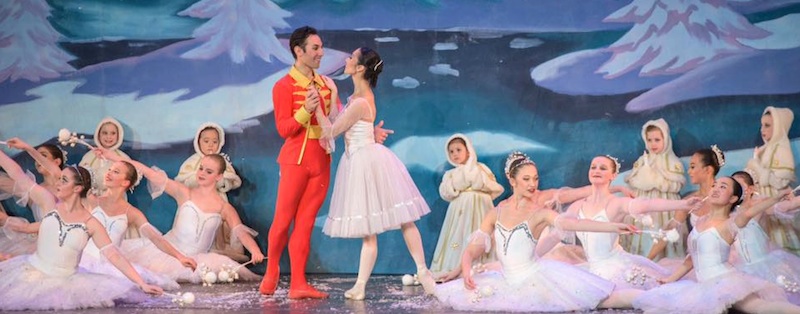Review: Academy of Russian Classical Ballet’s "The Nutcracker" at the Michigan Theater

This time of year some people need to hang lights, some people need to watch It’s a Wonderful Life and How the Grinch Stole Christmas? and some people need to attend a performance of The Nutcracker.
The ballet scratches a certain holiday itch with its familiar Tchaikovsky score and story of a Clara, a young girl who receives a nutcracker doll at her family’s Christmas party and, after a bit of magic, helps her now-human nutcracker prince defeat an army of giant mice. They celebrate by traveling through a snowstorm to the Kingdom of the Sweets where they are entertained by politically incorrect dances from faraway lands. All right, the plot isn’t its strong point, but a good Nutcracker hooks a certain segment of the population with its holiday appeal and lovely dancing.
As a member of that somewhat rarefied demographic, I went away satisfied from The Academy of Russian Classical Ballet’s production at the Michigan Theater on Saturday, December 10. I’m betting that the families there -- with children all dressed up and out past bedtime in a grand downtown theater -- also felt the itch scratched. It hit all the right notes with its convivial party scene and high-spirited dancing.
This particular Nutcracker had a dual identity; it was not only a legitimate theatrical production but also something of a recital for ballet school students. As such, the audience also included plenty of proud parents, cheering for the accomplishments of their kids. To be sure, every Nutcracker features children -- you can’t stage a party scene without them. This version, however, was almost totally reliant on them; the bulk of the show rested on the shoulders of six or eight teenage girls. The costume changes backstage must have been ridiculous; I tracked one young dancer who played six different parts throughout the show.
Luckily, these girls were up to the job -- I’m thinking particularly of the soloists in the “Marzipan” dance and in the “Waltz of the Flowers.” Musically sensitive, with easily flowing upper bodies and sharp pointe work, these dancers capably carried off this dancing that usually falls to corps members and soloists in a professional ballet company. Throughout the performance, the corps de ballet work -- groups of dancers in fine-tuned unison that results in pretty geometric formations on stage -- was also commendable.
Less successful was Artistic Directors Jessica and Nikolai Morschakov’s choice to frequently include smaller children in sections that require really rigorous dancing, such as “Waltz of the Snowflakes” and “Waltz of the Flowers.” These younger dancers crowded an already somewhat cramped stage and did not enhance the fine dancing of the older girls. There were plenty of opportunities for parents to admire their little ones in the party scene and in traditional roles of adorable Mice or Snow Angels. Younger kids even got added stage time in some of the Act II "Kingdom of the Sweets" dances (although this choice was sometimes dubious too, as in “Arabian Dance” -- an 18-year-old in a midriff-baring top and harem pants performing sinuous maneuvers is one thing, but what to make of the six elementary-school-age girls backing her up?).
Not unusual for a community-based Nutcracker, two imported professional guest artists took starring roles: Russians Albina Colobova as grown-up Clara and Aldar Sarsimbaev as the Nutcracker Prince. Sarsimbaev dazzled with firecracker virtuosity in his solos and somewhat eclipsed Colobova when they shared the stage; while her technique is flawless, her dancing was short on personality.
Throughout the performance, the dancers maintained a fine, unaffected stage presence. Especially in Act I, responding to the enigmatic magician Drosselmeyer (a role ably filled by the charismatic Justin Alesna), the children were a credit to some apparently excellent acting coaching.
While I’ve admitted that The Nutcracker isn’t long on plot coherence, this particular version several times undermined what dramatic clarity the ballet does have. For example, having an actual child represent Drosselmeyer’s gift of a nutcracker, rather than a wooden toy, makes it hard to convincingly play the moment when Clara’s naughty brother breaks it. The bent-over child doesn’t “read” as broken, and Clara can’t cradle it in her arms, disabling this key moment that seals Clara’s affection for the doll.
Most disappointing was the battle scene between mice and toy soldiers. While the Mouse King was appropriately creepy with his red eyes, his army was far from convincing; some mice were too tiny and cute to be of any use in a fight. And it was the battle that wasn’t; mice turned heavy cartwheels in ragged lines while the soldiers marched in place. In the battle recap that occurs at the beginning of Act II, the Nutcracker Prince did a series of virtuosic spins in place rather than engaging the Mouse King directly, and even my 8-year-old companion was skeptical of this supposed duel: “Why doesn’t he just fight him?” The Nutcracker does eventually stab the Mouse King with his sword, but it seems like an afterthought. Without the presence of some measure of real conflict between the forces of good and evil, the story is rendered even flimsier.
I would be a Christmas curmudgeon if I finished on that note, so let the last word be a merry one. While Ann Arbor doesn’t have a resident professional ballet company, it has a fine Nutcracker with the Academy of Russian Classical Ballet. Girls sashay between childhood security and a dream of sweet adulthood, love prevails, and all is merry and bright.
From 1993-2004, Veronica Dittman Stanich danced in New York and co-produced The Industrial Valley Celebrity Hour in Brooklyn. Now, PhD in hand, she writes about dance and other important matters.


































